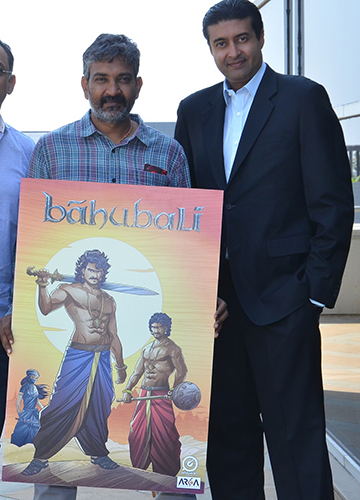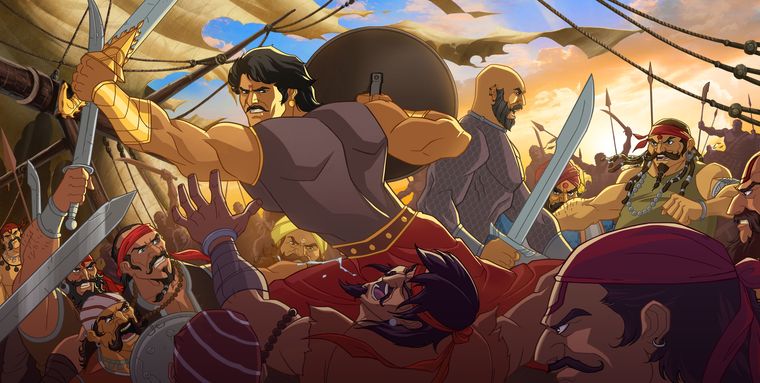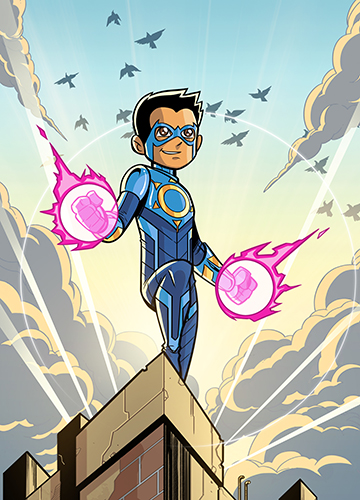Immortality, begins Disney+Hotstar’s animated show The Legend of Hanuman, means different things to different beings. Some will tear the universe apart to gain its power. But for others, it is about finding the true hero within through faith and hope. This sets the tone for the epic good vs evil battle between Ravan and Lord Hanuman in the series. According to its co-creator Sharad Devarajan, most stories about Hanuman either focus on his impish childhood or his leap to Lanka. But between these two realities lies a rich tale of pathos and profundity. Of a god who is made to forget his own immortality until he truly understands its power and can wield it responsibly.
“Through the show, one of the themes we wanted to explore was the duality of immortality,” says Devarajan. “Ravan is craving immortality, but he never had a purpose to his life. This purposelessness made him numb, and the numbness started to take over. The obsession with Sita and everything that led to his downfall was because he was void in his soul. Immortality without purpose is an endless torture. Whereas Hanuman is also immortal, but has this deep connection to Ram. So, his immortality is filled with great purpose, joy, and love.”
The show is visually stunning, and imbues the much-loved story of Hanuman with depth and poignancy. Upon its launch in 2021, it became the most watched show across all streaming platforms and has now been renewed for a third season.
Just like Hanuman, who had a lifetime of preparation before he came into his own, Devarajan, too, has been preparing all his life to realise his purpose. As one of the few Indians in his neighbourhood in New Jersey, Devarajan grew up with an acute awareness of being different. He found the love of his life at the age of five when he picked up his first comic book from a rack in a 7-Eleven. Comics gave him a unique sense of identity, because their heroes were always outliers like him. Their strength was their uniqueness and embracing it gave them purpose. Since then, comics became his staple, not just reading, but also drawing them. “The purist medium I always found for art was comic books,” he says. “It was a place where imagination was unbridled, and you could create the entire universe in a single page and destroy it in the next.”
As a child, Devarajan was reading Amar Chitra Katha with equal voraciousness as Marvel and DC comics. This straddling of the east and the west, in some way, is the story of his life. Through his work, he allows each to stream into the other. Right after college, he founded his first company, Gotham Comics, where he brought western comics to south east Asia and India, to people who could not afford or access them in their own language. Later, he co-founded Liquid Comics, where he collaborated with the likes of Guy Ritchie and John Woo to create original projects and graphic novels. He is also the CEO and publisher of Virgin Comics LLC and Virgin Animation Pvt. Ltd, a set of companies he co-founded with Sir Richard Branson. His latest ventures are Graphic India, under which he released the likes of The Legend of Hanuman, and Toonsutra, India’s biggest comic and webtoon app which went live last month. He created the series Chakra The Invincible with the legendary Stan Lee, and Astra Force with Amitabh Bachchan. He is also the co-creator with S.S. Rajamouli and Arka Mediaworks of Baahubali: The Lost Legends, which premiered on Amazon Prime Video in India, and the co-producer of Zoya Akhtar’s upcoming movie, The Archies.
For the last 15 years, Devarajan has been an adjunct professor at Columbia Business School, teaching a course in media and entrepreneurship. He says one of his biggest learnings in entrepreneurship has been the importance of timing. “Can you really have the right timing for the business you want to launch?” he asks. “It’s a bit of luck and art to be able to do that.” If your idea is too ahead of its time, then people won’t buy it, but if it’s too far behind, then everybody’s going to do it. There’s a bit of alchemy to it, he says with a smile.
Currently, however, it looks like he is at the right place at the right time. The Indian animation and VFX industry has been witnessing a renaissance ever since the pandemic. According to Statista, it was valued at approximately Rs107 billion in 2022. The animation, visual effects, gaming and comics (AVGC) sector now accounts for about 20 per cent of the Indian media and entertainment landscape. “Every day I meet creators in the country who are pushing the boundaries of risk-taking,” says Devarajan. “Risk aversion is something that is steeped in our culture. But the reality of being a creator is to live in the area of risk, to put everything out there and to really go for it. We are advancing in world-building, and I have seen some of the most sophisticated sci-fi, fantasy and superhero writing from India. Our goal is to nurture it.”
He says that while there is a huge animation outsourcing industry in India, he wants to change the perception of India from being an outsourcer to the source. “We have a thriving Bollywood ecosystem, but where are the [Hayao] Miyazakis, the Steven Spielbergs, the Stan Lees?” he asks. He is trying to push for artists to take the risk of becoming artists, instead of merely executing someone else’s vision. Outside India, he sees a burgeoning interest in our culture, as portrayed through films like Rajamouli’s RRR and the Baahubali series.
In fact, Rajamouli gave him his biggest lesson in risk taking, says Devarajan. “Think about the risk of the Baahubali franchise,” he says. “Those guys pushed it to a level never seen before in Indian cinema, taking a risk that I would say no studio would take up. I think the history of Indian cinema will be defined as before and after Baahubali. When I went to meet Rajamouli [while working on Baahubali: The Lost Legends], I realised how important world-building was to him. He showed us how the films were just the tip of the iceberg when compared with the years they had worked on world-building. And the themes he explores―like dharma vs justice―are so unabashedly Indian and so globally accessible in the way he presents them.”
As far as the future of his industry is concerned, the biggest disruptor is going to be artificial intelligence, he says. In fact, he has been teaching it at Columbia. “What [Google CEO] Sundar Pichai said many years ago was so prescient: that AI would be more important than fire,” he says. “Think about how tech has evolved in the last 200 years and then imagine the next 10 years being that equivalency. With the power of AI increasing, what we need to teach our students is a true comfort with ambiguity, with the ambiguous future that lies ahead. The things we thought we were in control of―industries we spent many years training for―might not even exist anymore. So how do we, as human beings, find different truths? It is going to force a rethink, not just in my industry, but in every industry.”





